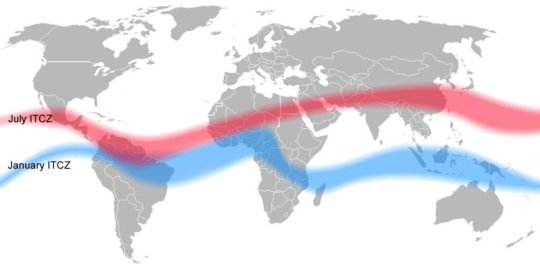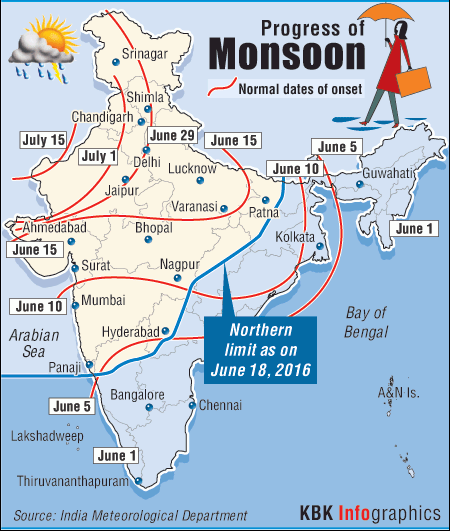Last Monday I posted some diagrams, animations, and predictions for El Niño and La Niña. So this week we’ll shift from the Pacific Ocean to the Indian Ocean and check in on the South Asian monsoon. “Monsoon” is really just another word (of Arabic origin) for “season”, but it’s typically used to describe places with distinct wet and dry seasons caused by a reversal in the dominant regional winds. There are several factors that impact any monsoon, and in India three important ones are:
- The position of the “Intertropical Convergence Zone” (ITCZ)
- Land heats up and cools down much more easily than water.
- The Himalaya
Although the relative importance of #1 & #2 for South Asia is still debatable, most traditional explanations focus on #2, possibly because it is easier to explain…
Figure 1 is a diagram from Thomas Reuters that depicts the traditional explanation for why monsoons in South Asia (and elsewhere) occur. The theory goes that:
- Land heats up rapidly during summer, while the ocean heats up slowly, so the land surface ends up hotter than the ocean surface.
- Hot air is less dense, making it buoyant and likely to rise.
- Rising air over land is replaced by cooler ocean air from the southwest, which brings ample moisture with it.
- This moisture-bearing air then rises over the Indian sub-continent, cooling down, which causes condensation (cloud formation) and rain, rain, rain.
In winter, this all works in the opposite direction:
- Land cools down more quickly than the ocean, so by mid-winter the air over the ocean is warmer.
- Rising air is limited to the ocean, and India experiences sinking air instead.
- On top of that, winds blow from the northeast over India to replace the air that’s rising to the south, and those northeasterly winds are dry because they come from interior Asia.
In this way, land-sea contrasts help form the monsoon — a seasonal oscillation of southwest to northeast winds and wet to dry seasons. You’ll see this same description in many animations of the monsoon, too, like this one from NASA:
However, these explanations are incomplete. Land-sea contrasts are just one factor impacting monsoons. If they were the only factor, we’d expect monsoons to exist everywhere with a strong warm/cold season and a land/sea boundary. We’d also expect monsoons to be absent anywhere without a strong land/sea contrast or warm/cold season. Neither of these is true. The Sahel in Chad is far from any ocean but has a monsoon climate, and islands like the Galápagos and New Caledonia have a monsoon despite being surrounded by the Pacific Ocean. Meanwhile, places like North Carolina and France have strong winter/summer contrasts in temperature but no clear wet/dry season, and even coastal places like San Francisco, USA or Luanda, Angola, which have distinct wet/dry seasons, lack the wind reversal characteristic of a monsoon.

Figure 2: Seasonal shifts in the Intertropical Convergence Zone (ITCZ) — the main tropical rain belt. (Image Credit: Mats Halldin)
The South Asian monsoon cannot be understood without another aspect: the Intertropical Convergence Zone (ITCZ). This is a zone of hot, rising air throughout the tropics. This air cools at it rises, causing condensation and rainfall. It occurs primarily because the tropics receive more direct sunlight than anywhere else in the world, and because of that solar control, the ITCZ drifts northward in May through July and southward in November through January, following the Sun. It happens over land and water alike, but the shifting tends to be more prominent over land areas, which can heat up and cool down more quickly. In other words, when you combine the concept of land-sea contrast with the concept of the ITCZ, its understandable that the monsoon in South Asian is particularly strong. Both are working in concert.
You can see the progression of the monsoon northward across India throughout June and July (Figure 3). It’s mostly a south-to-north progression, but also largely east to west. Again, this is due to a convergence of factors, not just land/ocean heating contrasts.

Figure 3: Progress of the 2016 summer monsoon in India compared to normal. (It was a late monsoon year.) Source: India Meteorological Department.
However, the South Asian monsoon also would not be nearly so strong without the Himalaya — the highest mountains in the world. These mountains are so imposing that they effectively block advancement of winds blowing from the southwest. Warm, moist air from the Indian Ocean stalls out in the Himalayan foothills, making Bangladesh the wettest place on Earth.
This video and animation from JeetoBharat, an Indian mentoring and test-prep organization, does a better job incorporating the multiple facets of the South Asian monsoon:



